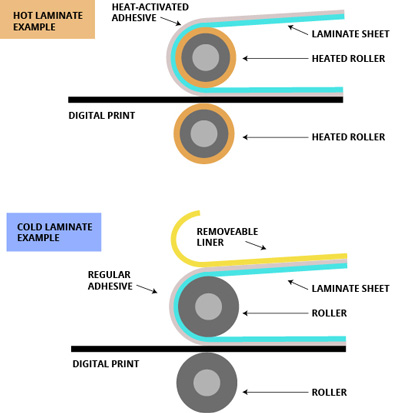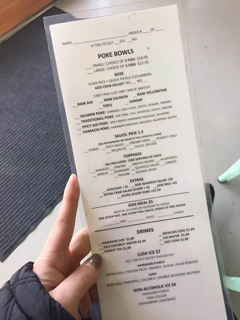| WHAT IS LAMINATION |
 |
| Lamination refers to the process of bonding a clear plastic film onto printed matter. When the film hardens, its rigidity strengthens the durability of the print. In addition, the laminate also protects the print from stains, smudges, moisture, wrinkles or tears. It’s most often used on printed material that is expected to be used frequently, such as menus, signs, educational materials, bookmarks, etc.
|
| THE PROCESS OF LAMINATING |
 |
|
Lamination is achieved by using heat and/or pressure to bind the plastic to the print. Typically, the print is placed between two sheets of film, and both are pressed through either a heat or cold roll laminator.
Heated roll laminators will melt the glue that has been applied to the lamination film, which will seal the two films around the print. This is the most common method of lamination, as it is often lower-cost, has a high adhesion level, and is not affected by moisture during the application.This process is also called “thermal lamination”.
Cold laminators rely on the film’s internal adhesive to stick to one another. This method is recommended when a print is sensitive to heat or has adhesion problems.
In both processes, the print is put through two rollers to ensure a tight, smooth, and seamless look. This will protect the document or print on both sides, as well as along the edges. The number of rollers involved can also affect the quality of the lamination. 2-roller machines are the most economical, and are often found in smaller laminators found in homes or offices. 4 rollers are more consistent and thorough, while 6-roller machines are often used for photo quality artwork with bubble-free lamination. The more rollers a machine has, the more likely it can provide a consistent and even heat distribution.
Most laminators protect both sides of a document or print. While single-side lamination is also achievable, it is more difficult to do and less common to find.
|

|
| BENEFITS OF LAMINATION
|
 |
|
There are many benefits to laminating print. Some include:
- Increased durability, allowing the print to withstand frequent use
- Protection against contaminants such as fingerprints, smudges, stains, tears, wrinkles, marks, grease, dirt, moisture
- The benefits of lamination
- Improved appearance by enhancing ink colors of the printed material, creating more vibrant, professional look
- Adds rigidity and strength
- Fully transparent
- Low cost, and due to increased lifespan of prints, saves money on reprinting
- Because of its plastic surface, they can also make great dry erase boards
|

With a hard laminate on top, menus are protected
from spills and wear-and-tears.
|
| LAMINATE THICKNESSES, FINISHES AND EDGES
|
 |
|
Laminate film can come in a variety of thickness, finishes and edges. Their thickness is measured in mils, which is the same as 1/1000ths of an inch (not to be confused with millimetres). Therefore, a laminate film that is 1.5mil would be 0.0015” thick after it’s been pressed. Commonly, laminate films run in the following thicknesses:
- 1.5 and 3 mil. These are super thin and will make your documents flexible. Often used in offices and schools, they provide some protection, but are at risk of peeling and breaking when the document is folded or creased.
- 5 mil. These are fairly strong, and will prevent your document from being folded or crumpled. They are also more or less waterproof.
- 7 and 10 mil. These are the strongest thicknesses, and are nearly indestructible once laminated with the print. Since they are also capable of protecting documents from UV rays, they are most often used on outdoor signs, as well as ID cards and security badges.
When purchasing a laminating machine, make sure the film thickness is compatible with your machine!
Laminating finishes also come in a variety of sheen levels. They can come in gloss, satin/lustre, or matte, but the most common options are gloss and matte.
- Gloss laminates - these types of laminate are highly reflective, but also deepen colors and are very eye-catching. They’re glass-like and are excellent for pieces that are meant to grab your attention: covers, signs, showroom displays, etc.
- Matte laminates - these are softer in appearance, and have reduced glare. They make an excellent choice for material that needs to be read, such as maps, menus, etc. They are also popular among artists to seal in posters and prints.
- UV laminates - these laminate films are specially engineered with ultraviolet inhibitors to reduce graphic fade and prevent ink from deteriorating. The inhibitors are usually either UV absorbers or stabilizers, which will either absorb or neutralize UV light before it can harm the ink beneath. UV laminates can protect the print from UV damage by slowing the ink fading process, but cannot guarantee the print from being damaged by UV light eventually. Usually most UV laminates for outdoor sign usage is guaranteed for six months.
With lamination, you can also have a sealed edge or a flush edge. Each as it’s own pros and cons.
- Sealed edge - this kind of edge means the lamination film extends beyond the edge of a print, creating a clear border around it. This means the edges are fully sealed from moisture or damage.
- Flush edge - this kind of edge is achieved when the border of the laminate is sliced off along the edge of the print, so only the front of the back of the print shows laminate. This exposes the edge of the print to the environment, so moisture can seep within the core of the print. Because this type of laminate is not as durable, it is only chosen for aesthetic reasons
|


Laminates come in all sorts of thicknesses and sheens. In the example above, the business cards are laminated with a sealed edge.

An example of a flush edge, with a satin-matte laminate.
|
| HOME / OFFICE LAMINATORS
|
 |
|
Laminators come in all shapes and sizes. The most commonly used laminator for home and office tends to be the pouch laminator. Pouch laminators are used to laminate smaller objects, usually ranging from small ID cards to large documents that may be poster-size. The “pouch” is made up of two laminating films that are attached on one side, making it easy to slide the document in and fit it between the laminating sheets. These pouches come in a variety of pre-cut sizes in order to cut down waste and trimming time. Due to the higher polyester-to-adhesive balance in laminating pouches, they also feel heavier and stiffer than laminating film.
|

An example of a desktop office laminator.
|
| INDUSTRIAL GRADE LAMINATORS
|
 |
|
Often, printing companies will use roll laminators as their method of laminating. Industrial-sized roll laminators are designed for high quality, high volume laminating, and are capable of laminating large sizes - from large documents to outdoor posters or banners.
Roll laminators usually use two rolls of laminating film - one above the feed tray, and one below it. The print is placed on the feed tray and gently pushed towards the laminator. The rollers pull the document along with the film. The print re-appears on the other side of the machine fully laminated, and often requires a bit of trimming along the edges.
The greatest benefit of laminating film is their versatility. They can come in various finishes, weights and thickness, such as (but limited to) matte, matte UV, gloss, etc. Lighter films are especially excellent for large, artistic displays, as they can be nearly undetectable with the naked eye.
|

An example of an industrial-grade laminator.
|
| OPINIONS ON LAMINATION
|
 |
|
When used for offices, crafts, and home, usually lamination is well-received. Its rigid surface provides protection and its glossy surface usually deepens and enhances the print. However, for the same reason, lamination can sometimes be viewed as cheap and tacky when used outside of a functional purpose.
That being said, laminates can still be found in the art world. Plaque mountings, for example, are all finished with a matte laminate on top in order to protect the poster or certificate from damage and moisture. Because the film is a softer and matte, it is hardly noticeable, and thus appears more timeless. With the edges of the print also sealed alongside the wood, there is less risk that the laminate will be “opened”, as the wood would also have to be cut to break the bond. This all helps with the print’s protection, as well as showcasing its true colors without reflective interference.
|
| At KeenArt Media, we offer laminating services for all your fine-art needs. Using a cold-press industrial-sized laminator, we are able to finish off your photographic prints with a soft, clean sheen that will protect them for years to come. We also offer laminates with our plaque mounts as well, securing your photographs, awards, and artwork with vibrancy and protection.
If you have any questions about the printing process for laminating your print or posters, do not hesitate to contact us. Our friendly and knowledgeable staff are always happy to help you get exactly the product you are looking for.
|
|

